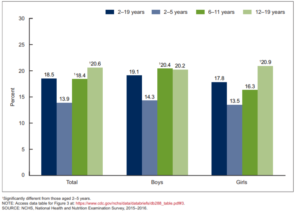Speaking further on the topic, obesity in children is not fake news and, in fact, rising dramatically with recently published data showing a much larger percentage of children in the U.S., as high as 20%, as overweight1. Obesity rates are much higher in African American and Hispanic children as compared to Asian and Caucasian children. Childhood obesity is worrisome as the fat cells that accumulate are extremely difficult to get rid of as adults, who in turn have an increased likelihood of developing obesity-related illnesses during the young adult years, such as type II diabetes, heart disease, and cancer. The “baby fat” continues well into adulthood, now more dangerous than cute.

Childhood obesity continuing into adulthood leads to an
increased risk of metabolic syndrome.
With vending machines selling sugar-laden snacks and beverages in abundance in schools, studies have shown that the kids are increasingly tempted to buy these high-calorie-low-nutritive value foods and drinks rather than their healthier counterparts2. Moreover, the subsidies given to corn manufacturers lead to cheaper and increased production of High Fructose Corn Syrup (HFCS) and other sweeteners, increasing their intake whereas no subsidies for fresh vegetables and fruits make them more expensive, lowering their consumption. In the end, the greater abundance and affordability of sugary foods and drinks along with poor awareness of healthier alternatives quickly adds up to childhood obesity. Continuing into adulthood, obesity leads to increased risk of metabolic syndrome and its associated adverse effects.
It is important that Pediatricians do not shame their obese and overweight patients, as it may be detrimental to their care and self-esteem. Instead, healthcare providers should spend a great deal of time counselling parents and children, which, to be fair, is easier said than done. Unfortunately, insurance companies do not make it any easier by not covering nutrition counselling more than twice a year. Since minority children are disproportionately affected, they do not get the care and counselling they deserve. The increase in screen times and a reduction in energy expenditure are additional factors that play a role in the obesity epidemic.
World Health Organization (WHO) Data4:
41 million children under the age of 5 were overweight or obese in 2016.
Over 340 million children and adolescents aged 5-19 were overweight or obese in 2016.
Moreover, there are new diet fads identified frequently, and social media sites like Facebook tout new food combinations almost daily. Cholesterol was the evil for the longest time, but strictly low carbs and high protein do not fare any better either in sustaining weight loss. Continued consumption of sugar-sweetened beverages leads to fatty liver (deposition of fat in the liver), which eventually can lead to illnesses even in children as young as eight, and adult onset diabetes seen in teens. Diet sodas are not the panacea they claim to be, as despite the lack of sugar, they turn on certain genes, which engender poor satiety and increased caloric intake.
This obesity epidemic is a phenomenon across the globe, and recently the WHO predicted that we have reached a state for first time where more people are dying from increased consumption of food vs lack of food4. In the U.S., the current administration has delayed certain measures like food labels, which were to go into effect for restaurant meals. On a local level, not all is lost yet, as towns and counties have taken notice and introduced a “soda tax”. Early results show that an excise tax on sugary drinks led to a 21% reduction in their consumption in Berkley, CA.
Here is what all parents should do:
- Consult with your child’s physician for a nutrition plan.
- Identify your child’s ideal body weight and calculate the body mass index (BMI). BMI Calculators are available on the Centers for Disease Control and Prevention (CDC) website. In children, if the BMI is above 85%, they classify as overweight.
- Beware of fad diets as they are just that – fads, a short-lived and often unsubstantiated craze, that do not lead to maintainable weight loss.
- Curtail sugar intake, as that is the key contributor to inflammation and the development of metabolic syndrome.
- Ensure your child is participating in at least 1 hour of physical activity daily5.
- Shop, cook, and serve healthier foods and restrict access to unhealthier options.
- Model healthy eating habits – a healthy diet to reduce the risk of obesity should include more fruits, vegetables, nuts, whole grains, polyunsaturated fatty acids, and long chain Omega 3 fatty acids and less red or processed meats, sodium, sugar sweetened beverages, and no Trans fats. Consuming whole grains (sprouted) are the healthiest as they have intact fiber and husk needed for ideal absorption. If the parent is on the above diet, it inculcates the same healthy eating habits in the child.
 Feel free to reach out with questions at dahod.idris@gmail.com and stay tuned for Health Insights at https://idrisdahodmd.com.Idris Dahod, MD (Pediatrics/Pediatric GI and Nutrition)References:1-Steven M Schwarz, MD, FAAP, FACN, AGAF; Chief Editor: Jatinder Bhatia, MBBS, FAAP- Obesity in Children Feb 20, 2019
Feel free to reach out with questions at dahod.idris@gmail.com and stay tuned for Health Insights at https://idrisdahodmd.com.Idris Dahod, MD (Pediatrics/Pediatric GI and Nutrition)References:1-Steven M Schwarz, MD, FAAP, FACN, AGAF; Chief Editor: Jatinder Bhatia, MBBS, FAAP- Obesity in Children Feb 20, 2019
2-Wiecha, J.L., Finkelstein, D., Troped, P.J., Fragala, M., & Peterson, K..E. (2006). School vending machines use and fast–food restaurant use are associated with sugar-sweetened beverage intake in youth. Journal of the American Dietetic Association, 106, 1624-1630. doi: 10.1016/j.jada.2006.07.007
Susann Weihrauch-Blüher,a,b,* Kartin Kromeyer-Hauschild,c Christine Graf,d Kurt Widhalm,e Ulrike Korsten-Reck,f Birgit Jödicke,g Jana Markert,a,h Manfred James Müller,i,j Anja Moss,j Martin Wabitsch,j and Susanna Wiegandg – Current Guidelines for Obesity Prevention in Childhood and Adolescence- Obesity facts, July 2018
4-https://www.who.int/news-room/fact-sheets/detail/obesity-and-overweight Feb 2018
5-Johnson, L.D., Delva, J., & O’Malley, P.M. (2007). Sports participation and physical education in American secondary schools. American Journal of Preventive Medicine, 33, S195-S207. doi: 10.1016/j.amepre.2007.07.015
6-CDC National Center for Health Statistics (NCHS) data brief Cdc-pdf[PDF-603KB]